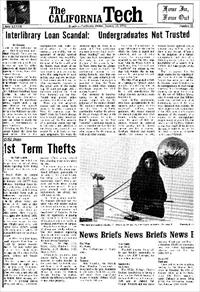Press
The California Tech

The California Tech is the student newspaper of the California Institute of Technology ("CalTech") in Pasadena, California, USA. In Volume 77, issue 13, dated 16 January 1976, Eric Carter reviewed Space: 1999 on page 5.
With the start of the 1975-76 TV season, the prolific British team of Gerry and Sylvia Anderson presented us with yet another of their science fiction orgies in special effects, this time circa 21st century, specifically space: 1999.
The Andersons are the people Who brought you the marionette populated SF shows Fireball XL5 , Supercar, Captain Scarlet and the Mysterions, and Thunderbirds. They also produced the live action feature film Journey to the Far Side of the Sun .
Space: 1999 somewhat of a milestone in television. It is the most expensive program ever made, taking two years and $7 million for the first 24 episodes. A substantial portion of this budget undoubtedly went to the salaries of 1999's stars, one of the Sixties' really dynamic television duos. 1999 also has the widest initial exposure for any series in history, simultaneously showing in over 100 countries This is a program that was rejected by the networks and is in syndication, penetrating 155 of the nation's TV markets.
The story concerns Alpha, Earth's colony of 300 people on the moon. The moon, being used as a cosmic dump for Earth's nuclear waste, is exposed to a previously unknown phenomenon, as the waste effects tremendous discharges in magnetic energies. The dump is abruptly transformed into the biggest bomb man has made since Grindl (A 1963 NBC sitcom that lasted one season).
Through this freak of nature and our physics, Luna is hurled out of Terra's grasp and into the limitless void, leaving Earth with earthquakes, tidal waves and a dubious fate at best.
Every week the Alphans encounter another nemesis, whether it be hostile aliens, friendly aliens, the elements, or themselves, all the while hoping for a tete a tete with a nice planet on which to live, not knowing if they are the last surviving component of Earth. After all, they are liable to bump into something sometime.
Martin Landau is believable as the tight-lipped authoritative Commander of Alpha, John Koenig, "We're just trying to survive"
Barbara Bain, Landau's real life wife, is the stolid, unemotional physician, Helena Russell, whose long-lost space man husband was found living on the antimatter planet Terra Nova. "I'm afraid we can never be together again." It looks like the glamour days of Cinnamon Carter are gone forever.
Barry Morse is Dr. Bergman, the resident scientist. He is my favourite character on the show, and is probably best known as the detective Who for seven years chased David Janssen around in The Fugitive.
There is a nucleus of regulars on the show, all very polished in their roles. These include the fiery Allan Carter, a shoot now, ask later pilot; Kano, the computer expert who has participated in experiments to connect the Human Brain to a computer; Paul, the cool, calm, and collected Main Mission controller, and Sandra, the petite European Main Missioner. The characters grow more familiar each week, as their pasts, presents, and futures are bared to the public. I cannot help but think of the similar way we grew to know the crew of the Enterprise so well.
Space: 1999, while at times suffering from aberrations of our current scientific knowledge (what do we know, anyway?), more than atones for this with its often cerebral, thought- provoking plots, and fine acting.
One of the best so far was the episode where the Moon encounters a black hole (complete with accretion disk, relativity trolls!) which proceeds to destroy one of the small Eagle spacecraft on a mission with the tremendous tidal forces, disrupting the very fabric of space and time. The Moon, destined for a similar fate, is spared by a benevolent cosmic consciousness, whose "brain" cells are the very stars we see in our Universe. The Alphans find themselves whisked literally millions of light years in seconds.
The crowning glory of Space: 1999, however, are the special visual effects. These are without doubt the finest ever for television, ranking somewhat below the finest ever done, those of Kubrick's masterpiece 2001: A Space Odyssey. From the futuristic sets housing the Alphans with their sleek Rudi Gernreich- designed uniforms to the external planet shots and alien landscapes, to the multitudes of spacecraft that are encountered, everything is done with great and meticulous detail and stunning beauty. These alone make the program worthwhile to watch; in colour, of course. One of my favourite sequences Occurred in the episode highlighting the fate of the Ultra probe of 1996, encountering a tentacled creature which resembled the local car wash. The scene of the routine during the 8 month voyage of the ship, backed by the serenity of Albinoni's Adagio easily ranked with the finest effects of 2001.
For you weapons fans there are lasers capable of stunning or killing the victim. and for everyone, a literal plethora of visual stimuli.
Space: 1999 has done phenomenally well for all of the independent stations which carry it. So well, in fact, that it has already been renewed for 1976-77, meaning 24 additional episodes with a budget increase of S25,OOO per show. Mourned, however, will be the loss of Barry Morse, who was getting insufficient work for his stature. Oh, well, c'est la vie. My set will be on, per usual.
- Eric Carter